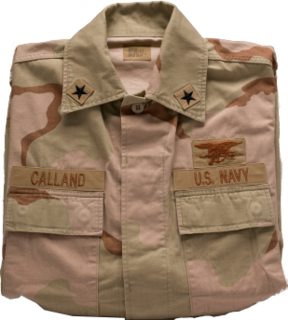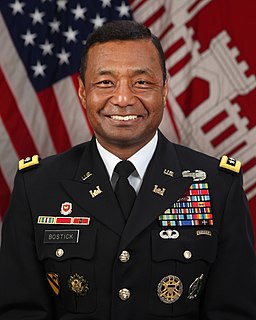
The United States Army (USA) is the land service branch of the United States Armed Forces. It is one of the eight U.S. uniformed services, and is designated as the Army of the United States in the U.S. Constitution. The oldest and most senior branch of the U.S. military in order of precedence, the modern U.S. Army has its roots in the Continental Army, which was formed 14 June 1775 to fight the American Revolutionary War (1775–1783)—before the United States was established as a country. After the Revolutionary War, the Congress of the Confederation created the United States Army on 3 June 1784 to replace the disbanded Continental Army. The United States Army considers itself to be a continuation of the Continental Army, and thus considers its institutional inception to be the origin of that armed force in 1775.

The United States Army Corps of Engineers (USACE) is an engineer formation of the United States Army that has three primary mission areas: Engineer Regiment, military construction, and civil works. The day-to-day activities of the three mission areas are administered by a lieutenant general known as the commanding general/chief of engineers. The chief of engineers commands the Engineer Regiment, comprising combat engineer, rescue, construction, dive, and other specialty units, and answers directly to the Chief of Staff of the Army. Combat engineers, sometimes called sappers, form an integral part of the Army's combined arms team and are found in all Army service components: Regular Army, National Guard, and Army Reserve. Their duties are to breach obstacles; construct fighting positions, fixed/floating bridges, and obstacles and defensive positions; place and detonate explosives; conduct route clearance operations; emplace and detect landmines; and fight as provisional infantry when required. For the military construction mission, the commanding general is directed and supervised by the Assistant Secretary of the Army for installations, environment, and energy, whom the President appoints and the Senate confirms. Military construction relates to construction on military bases and worldwide installations.
The Fleet Marine Force Warfare Insignia, also known as the Fleet Marine Force badge or FMF pin, are three military badges of the United States Navy which are issued to those U.S. Navy officers and sailors who are trained and qualified to perform duties in support of the United States Marine Corps. There are currently three classes of the Fleet Marine Force pin, being that of enlisted, officer, and chaplain.

The Mount Morris Dam is a concrete dam on the Genesee River. It is located south of Rochester, New York in the towns of Leicester and Mount Morris in Livingston County, New York, next to Letchworth State Park.

Fort McCoy is a United States Army installation on 60,000 acres (24,000 ha) between Sparta and Tomah, Wisconsin, in Monroe County. In 1909, there were two separate camps named Camp Emory Upton and Camp Robinson; in 1926, these camps were joined together to form Camp McCoy. Since its creation in 1909, the post has been used primarily as a military training center. A part of Fort McCoy is also used by the Wisconsin State Patrol as a training facility.

The Transportation Corps is a combat service support branch of the U.S. Army. It is responsible for the movement of personnel and material by truck, rail, air, and sea. It is one of three U.S. Army logistics branches, the others being the Quartermaster Corps and the Ordnance Corps. The Corps was established in its current form on 31 July 1942, with predecessor services dating back to the American Civil War. Currently headquartered at Fort Lee, Virginia, it is the second-largest branch of the Army. The officer in charge of the branch for doctrine, training, and professional development purposes is the Chief of Transportation (COT), a position currently held by Brigadier General James M. Smith. The Corps's motto is "Nothing Happens Until Something Moves".

The Bonnet Carré Spillway is a flood control operation in the Lower Mississippi Valley. Located in St. Charles Parish, Louisiana, about 12 miles (19 km) west of New Orleans, it allows floodwaters from the Mississippi River to flow into Lake Pontchartrain and thence into the Gulf of Mexico. The spillway was constructed between 1929 and 1931, following the Great Mississippi Flood of 1927, and has been designated as a National Historic Civil Engineering Landmark by the American Society of Civil Engineers.

The 325th Infantry Regiment is a light infantry parachute insertion fighting force of the United States Army. The subordinate units of the regiment constitute the bulk of the infantry elements assigned to the 2nd Infantry Brigade Combat Team, 82nd Airborne Division.

The Desert Combat Uniform (DCU) is an arid-environment camouflage uniform that was used by the United States Armed Forces from the mid-1990s to the early 2010s. In terms of pattern and textile cut, it is identical to the U.S. military's Battle Dress Uniform (BDU) uniform, but features a three-color desert camouflage pattern of dark brown, pale olive green, and beige, as opposed to the four-color woodland pattern of the BDU. It replaced the previous Desert Battle Dress Uniform (DBDU) which featured a six-color "chocolate chip" pattern of beige, pale olive green, two tones of brown, and black and white rock spots. Although completely phased out of frontline use in the U.S. Armed Forces, some pieces and equipment printed in the DCU camouflage pattern are used in limited numbers such as MOPP suits and/or vests.
Suzanne Fournier is a former Chief of Public Affairs for the U.S. Army Corps of Engineers (USACE) in Washington, DC.
Tarīnkōṭ, also spelled as Tarin Kowt, is the capital of Uruzgan Province in southern Afghanistan in the Tarinkot District. Tarinkot city has a population of 71,604 (2015), with some 200 small shops in the city's bazaar.

The 13th Sustainment Command (Expeditionary)—the "Lucky 13th"—is a U.S. Army modular sustainment command which serves as a forward presence for expeditionary operations for a theater, or in support of a regional combatant commander. Expeditionary sustainment commands (ESC), such as the 13th, synchronize distribution of supplies and services within their operational areas and provides distribution oversight. Formed at Fort Hood, Texas when the 1st Logistics Command deployed to Vietnam, the organization then known as the 13th Support Brigade was initially responsible for the training of technical services units to assume combat service support missions in Southeast Asia.

Shindand Air Base is an Afghan Air Base located in the western part of Afghanistan in the Shindand District of Herat Province, 7 miles northeast of the city of Shindand. The runway has a concrete surface. An all weather asphalt road connects it with the Kandahar–Herat Highway, part of Highway 1. The base is of great strategic importance being just 75 miles from the border of Iran. It is capable of housing over one hundred military aircraft.

Fern Ridge Reservoir is a reservoir on the Long Tom River in the U.S. state of Oregon. The reservoir is located approximately 12 miles (19 km) west of Eugene on Oregon Route 126. The reservoir is a U.S. Army Corps of Engineers flood control project encompassing more than 12,000 acres (49 km2) and is a popular site for boating, fishing, and birdwatching.
There were 2,448 United States military deaths in the War in Afghanistan. 1,921 of these deaths were the result of hostile action. 20,752 American servicemembers were also wounded in action during the war. In addition, 18 Central Intelligence Agency (CIA) operatives also died in Afghanistan. Further, there were 1,822 civilian contractor fatalities.

Camp Leatherneck was a 1,600 acre United States Marine Corps base in Helmand Province, Afghanistan. The site was mostly in Washir District and was conjoined with Camp Bastion, which was the main British military base in Afghanistan and Camp Shorabak which initially was the main Afghan section however the three sites were joined together under the name of 'Camp Shorabak' in 2014.

Thomas Paul Bostick was the 53rd Chief of Engineers of the United States Army and Commanding General of the U.S. Army Corps of Engineers. Since the creation of West Point in 1802 as the Nation's first engineering school, Bostick is the only African American graduate of the academy to serve as the Chief of Engineers and Commanding General of the U.S. Army Corps of Engineers. Following his military career, Bostick served as the Chief Operating Officer and President of Intrexon Bioengineering. He serves on the Boards of CSX, Perma-Fix, Fidelity Investments' Equity and High Income Fund, HireVue, and American Corporate Partners, a 501(c)(3) organization dedicated to assisting U.S. Veterans in their transition from the armed services to the civilian workforce. He is also a Forbes Contributor.

Bowman-Haley Dam is an embankment dam located in Bowman County, North Dakota, in the southwestern part of the state. The dam is just over 2 miles north of the South Dakota border.
Initiated in 2013 by the 38th Chief of Staff of the United States Army, Raymond T. Odierno, regionally aligned forces (RAF) provide combatant commands (CCMDs), scalable and tailorable Army capabilities for all requirements, including operational missions, bilateral and multilateral military exercises and security cooperation activities. Army regional alignment is an organizing principle that improves the Army's ability to provide units and capabilities. Regional alignment provides focus and direction for unit training and preparation. RAFs are drawn from the Army Total Force, which includes active United States Army, the Army National Guard and the United States Army Reserve. Corps and divisions are aligned to ensure joint task force capability to every geographic combatant command (GCC). Through regional alignment, the Army maintains its war-fighting skills and complements these skills with language, regional expertise and cultural awareness training.

The greater New Orleans Hurricane & Storm Damage Risk Reduction System (HSDRRS) is an infrastructure systems in southern Louisiana which seeks to provide the greater New Orleans area a 100-year level of risk reduction, meaning reduced risk from a storm surge that has a 1% chance of occurring or being exceeded in any given year. In 2019, the Army Corps of Engineers announced that due to increased rate of sea level rise and continued sinking of soil the levee system would no longer offer original planned levels of protection as early as the year 2023.















